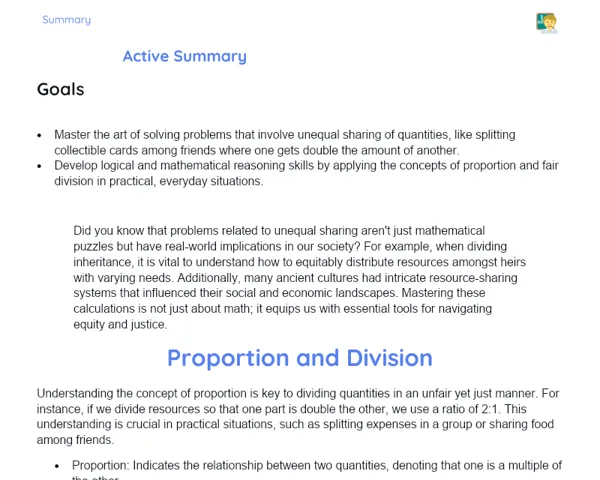Summary Tradisional | Basic Multiplication Facts
Contextualization
Multiplication is one of the fundamental operations in mathematics that we come across in our daily lives. Think of it as repeated addition – for example, to calculate 3 times 4, we can add 4 + 4 + 4 to get 12. This method makes the concept concrete and easier for our 3rd-grade students to grasp.
The basic multiplication facts, which cover numbers from 0 to 10, are essential because they lay the groundwork for more involved math problems. Once students get a hold of these facts, they can perform mental calculations more swiftly and with more ease. Also, understanding key properties like the commutative property (where switching the numbers doesn’t change the result) and the identity property (any number multiplied by 1 remains unchanged) is crucial for building further mathematical skills.
To Remember!
Concept of Multiplication
Multiplication, at its core, is repeated addition. For instance, 3 x 4 is just adding 4 three times. We often use everyday objects or simple drawings to illustrate this concept. Imagine you have 3 groups of 4 apples – when you count them altogether, you get 12 apples. This kind of illustration makes the idea more tangible for our young learners.
Another way to look at it is by thinking in terms of rows and columns. If there are 3 rows with 4 chairs in each, adding up the chairs across the rows gives 12 chairs. Such visual representations help in understanding multiplication as a process of repeated addition, which is essential for solving everyday problems like distributing items evenly or calculating quantities quickly.
-
Viewing multiplication as repeated addition.
-
Using physical objects or drawings to visualize the concept.
-
Practical use in everyday situations.
Basic Multiplication Facts
The basic multiplication facts include simple multiplications with numbers from 0 to 10. These facts serve as the foundation of more complex mathematics, enabling students to perform mental arithmetic quickly. For example, knowing that 4 x 3 = 12 or 2 x 5 = 10 equips students with the ability to handle more elaborate problems with greater confidence.
The importance of mastering these facts cannot be overstated: when students are familiar with them, they can focus more on understanding advanced topics without being bogged down by simple calculations. Regular practice not only sharpens their speed and accuracy but also boosts overall confidence in math.
-
Simple multiplications using numbers from 0 to 10.
-
A foundation for tackling more advanced math problems.
-
The value of regular, consistent practice.
Properties of Multiplication
Multiplication comes with useful properties that simplify both understanding and computation. For example, the commutative property tells us that 3 x 4 is the same as 4 x 3 – both giving 12. This flexibility is very handy in solving problems efficiently.
Another key property is the identity property. This means that any number multiplied by 1 remains unchanged – like 5 x 1 equals 5. Such properties help lay a strong foundation, making it easier for students to solve more complicated problems later.
By understanding and applying these properties, students can tackle mathematical challenges more effectively and grasp the logic behind the operations.
-
Commutative property: Switching the order of numbers doesn’t change the answer.
-
Identity property: Multiplying by 1 leaves the number the same.
-
Helps simplify and solve math problems efficiently.
Practical Examples
Using practical examples is one of the best ways to reinforce the basic multiplication facts. For instance, when exploring 2 x 3, we can demonstrate that it is equivalent to adding 3 two times (3 + 3), which equals 6. Solving such examples on the board allows students to follow along and practice simultaneously.
Another example is 4 x 5, which we can show as adding 5 four times (5 + 5 + 5 + 5), giving a total of 20. Repetitive practice in this way helps students to remember these facts better and perform calculations more accurately.
Moreover, applying multiplication in real-life scenarios – like counting groups of pencils or dividing items equally amongst friends – makes the lesson more relatable and dynamic.
-
Work through examples on the board.
-
Regular practice to solidify the basic facts.
-
Relating the concept to everyday situations.
Key Terms
-
Multiplication: A process that involves repeated addition of the same number.
-
Repeated Addition: The method of adding a number several times to reach a sum.
-
Basic Facts: Multiplication facts involving numbers from 0 to 10.
-
Commutative Property: The principle that switching numbers does not affect the product.
-
Identity Property: The rule that multiplying any number by 1 leaves it unchanged.
Important Conclusions
In this lesson, we explored the core idea of multiplication as repeated addition, making the concept easier for students to visualise with practical examples and concrete objects. We emphasized the importance of mastering the basic multiplication facts with numbers from 0 to 10, as these form the building blocks for tackling advanced math problems.
We also discussed important properties such as the commutative property (the order of numbers does not affect the result) and the identity property (any number multiplied by 1 remains the same). These properties are key to simplifying and solving mathematical problems efficiently. Regular practice of these basic facts is essential to enhance both speed and accuracy in calculations.
Finally, using practical examples on the board and encouraging hands-on practice helps reinforce these concepts, making math more accessible and engaging for our students.
Study Tips
-
Practice basic multiplications daily, perhaps using flashcards to remember the facts better.
-
Integrate multiplication problems into everyday tasks, like calculating ingredients in a recipe or sharing items equally.
-
Regularly review the properties of multiplication to ensure a strong grasp, thereby improving problem-solving skills.



